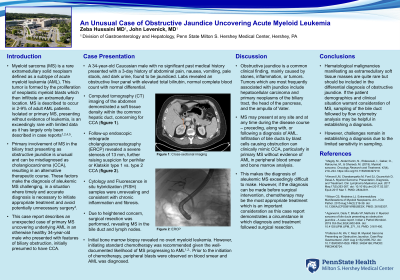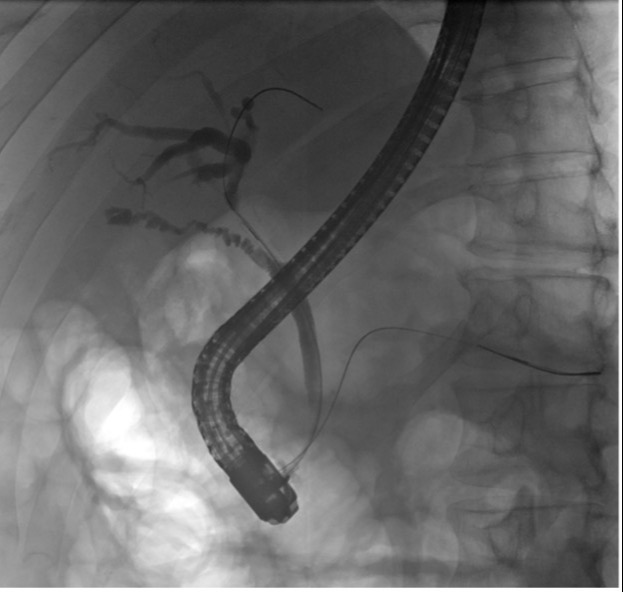Tuesday Poster Session
Category: Biliary/Pancreas
P2912 - An Unusual Case of Obstructive Jaundice Uncovering Acute Myeloid Leukemia
Tuesday, October 24, 2023
10:30 AM - 4:00 PM PT
Location: Exhibit Hall

Has Audio
- ZH
Zeba Hussaini, MD
Penn State Hershey Medical Center
Hummelstown, PA
Presenting Author(s)
Zeba Hussaini, MD1, John Levenick, MD2
1Penn State Hershey Medical Center, Hummelstown, PA; 2Penn State Hershey Medical Center, Hershey, PA
Introduction: Myeloid sarcoma (MS) is a rare extramedullary solid neoplasm and a subtype of acute myeloid leukemia (AML), occurring in 2-9% of adult AML patients. Isolated or primary MS, presenting without evidence of leukemia, is exceedingly rare, only described in case reports. Furthermore, primary involvement of MS in the biliary tract presenting as obstructive jaundice is unusual and can be misdiagnosed as cholangiocarcinoma (CCA), resulting in an atypical therapeutic course. This case report describes an unexpected case of primary MS uncovering underlying AML in an otherwise healthy male who presented with features of biliary obstruction, initially presumed to have CCA.
Case Description/Methods: A 34-year-old male presented with abdominal pain, pale stools, and dark urine. Jaundice and scleral icterus were noted. Lab work indicated an obstructive liver panel with elevated total bilirubin. CT imaging demonstrated a soft tissue density in the common hepatic duct, possibly involving the right hepatic artery, raising concern for CCA. Follow-up endoscopic retrograde cholangiopancreatography (ERCP) revealed a severe stenosis in the main bile duct, raising suspicion for CCA. Due to heightened concern, surgical resection was performed, revealing myeloid sarcoma in the bile duct and lymph nodes. Initial bone marrow biopsy revealed no overt acute myeloid leukemia. Chemotherapy was recommended due to the risk of MS progressing to AML. Prior to the initiation of chemotherapy, peripheral blasts were observed on his blood smear and AML was diagnosed. Salvage chemotherapy was initiated and fortunately, repeat imaging and biopsy show no evidence of disease.
Discussion: Obstructive jaundice is often caused by stones, inflammation, or tumors. MS can occur anywhere in the body and at any stage of disease – preceding, accompanying, or following a diagnosis of AML. Bile duct infiltration by blast cells causing obstruction can mimic CCA, particularly in cases of primary MS without evidence of AML. This poses challenges in diagnosing aleukemic MS, but early identification before surgical intervention allows for appropriate chemotherapy treatment. Extramedullary soft tissue masses as manifestations of hematological malignancies are rare but should be considered in the differential diagnosis of obstructive jaundice. If clinical factors warrant suspicion of MS, sampling the bile duct followed by flow cytometry analysis may aid in establishing a diagnosis, although challenges remain due to limited sensitivity in sampling.

Disclosures:
Zeba Hussaini, MD1, John Levenick, MD2. P2912 - An Unusual Case of Obstructive Jaundice Uncovering Acute Myeloid Leukemia, ACG 2023 Annual Scientific Meeting Abstracts. Vancouver, BC, Canada: American College of Gastroenterology.
1Penn State Hershey Medical Center, Hummelstown, PA; 2Penn State Hershey Medical Center, Hershey, PA
Introduction: Myeloid sarcoma (MS) is a rare extramedullary solid neoplasm and a subtype of acute myeloid leukemia (AML), occurring in 2-9% of adult AML patients. Isolated or primary MS, presenting without evidence of leukemia, is exceedingly rare, only described in case reports. Furthermore, primary involvement of MS in the biliary tract presenting as obstructive jaundice is unusual and can be misdiagnosed as cholangiocarcinoma (CCA), resulting in an atypical therapeutic course. This case report describes an unexpected case of primary MS uncovering underlying AML in an otherwise healthy male who presented with features of biliary obstruction, initially presumed to have CCA.
Case Description/Methods: A 34-year-old male presented with abdominal pain, pale stools, and dark urine. Jaundice and scleral icterus were noted. Lab work indicated an obstructive liver panel with elevated total bilirubin. CT imaging demonstrated a soft tissue density in the common hepatic duct, possibly involving the right hepatic artery, raising concern for CCA. Follow-up endoscopic retrograde cholangiopancreatography (ERCP) revealed a severe stenosis in the main bile duct, raising suspicion for CCA. Due to heightened concern, surgical resection was performed, revealing myeloid sarcoma in the bile duct and lymph nodes. Initial bone marrow biopsy revealed no overt acute myeloid leukemia. Chemotherapy was recommended due to the risk of MS progressing to AML. Prior to the initiation of chemotherapy, peripheral blasts were observed on his blood smear and AML was diagnosed. Salvage chemotherapy was initiated and fortunately, repeat imaging and biopsy show no evidence of disease.
Discussion: Obstructive jaundice is often caused by stones, inflammation, or tumors. MS can occur anywhere in the body and at any stage of disease – preceding, accompanying, or following a diagnosis of AML. Bile duct infiltration by blast cells causing obstruction can mimic CCA, particularly in cases of primary MS without evidence of AML. This poses challenges in diagnosing aleukemic MS, but early identification before surgical intervention allows for appropriate chemotherapy treatment. Extramedullary soft tissue masses as manifestations of hematological malignancies are rare but should be considered in the differential diagnosis of obstructive jaundice. If clinical factors warrant suspicion of MS, sampling the bile duct followed by flow cytometry analysis may aid in establishing a diagnosis, although challenges remain due to limited sensitivity in sampling.

Figure: Endoscopic retrograde cholangiopancreatography (ERCP) image of a single severe stenosis 13 mm in length in the upper third of the main bile duct concerning for perihilar or Klatskin type 1 vs. type 2 cholangiocarcinoma.
Disclosures:
Zeba Hussaini indicated no relevant financial relationships.
John Levenick indicated no relevant financial relationships.
Zeba Hussaini, MD1, John Levenick, MD2. P2912 - An Unusual Case of Obstructive Jaundice Uncovering Acute Myeloid Leukemia, ACG 2023 Annual Scientific Meeting Abstracts. Vancouver, BC, Canada: American College of Gastroenterology.
